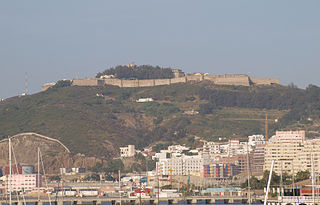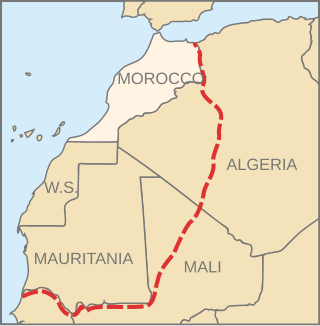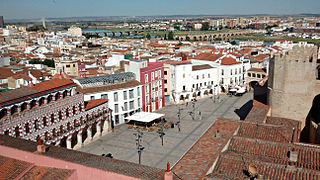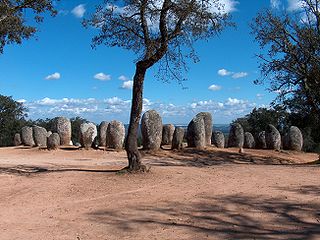
Ceuta is an autonomous city of Spain on the North African coast. Bordered by Morocco, it lies along the boundary between the Mediterranean Sea and the Atlantic Ocean. Ceuta is one of the special member state territories of the European Union, and it is one of several Spanish territories in Africa, which include Melilla and the Canary Islands. It was a regular municipality belonging to the province of Cádiz prior to the passing of its Statute of Autonomy in March 1995, as provided by the Spanish Constitution, henceforth becoming an autonomous city.

Melilla is an autonomous city of Spain on the North African coast. It lies on the eastern side of the Cape Three Forks, bordering Morocco and facing the Mediterranean Sea. It has an area of 12.3 km2 (4.7 sq mi). It was part of the Province of Málaga until 14 March 1995, when the Statute of Autonomy of Melilla was passed.

Perejil Island, also known as Parsley Island, is a small, uninhabited rocky islet located 200 metres (660 ft) off the coast of Morocco. It is administered by Spain as one of the plazas de soberanía, and its sovereignty is disputed by Morocco. It was the subject of an armed incident between the two countries in 2002.

The Ceuta border fence forms part of the Morocco–Spain border at Ceuta, a city on the North African coast. Constructed by Spain, its purpose is to prevent smuggling and to stop migrants from entering Europe. Morocco objected to the construction of the barrier since it does not recognize Spanish sovereignty in Ceuta.

The Spanish protectorate in Morocco was established on 27 November 1912 by a treaty between France and Spain that converted the Spanish sphere of influence in Morocco into a formal protectorate.

Juan Yagüe y Blanco, 1st Marquis of San Leonardo de Yagüe was a Spanish military officer during the Spanish Civil War, one of the most important in the Nationalist side. He became known as the "Butcher of Badajoz" because he ordered thousands killed, including wounded Republican soldiers in the hospital.

Monte Hacho is a low mountain that overlooks the Spanish city of Ceuta, on the north coast of Africa. Monte Hacho is positioned on the Mediterranean coast at the Strait of Gibraltar opposite Gibraltar, and along with the Rock of Gibraltar is claimed by some to be one of the Pillars of Hercules. According to the legend, Hercules pushed apart the two mountains and created a link between the Mediterranean and the Atlantic.

Greater Morocco is a label historically used by some Moroccan nationalist political leaders protesting against Spanish, French and Portuguese rule, to refer to wider territories historically associated with the Moroccan sultan. Current usage most frequently occurs in a critical context, accusing Morocco, largely in discussing the disputed Western Sahara, of irredentist claims on neighboring territories.
The Army of Africa, also known as the Army of Spanish Morocco, was a field army of the Spanish Army that garrisoned the Spanish protectorate in Morocco from 1912 until Morocco's independence in 1956.
The Battle of Mérida saw the Republican militia twice fail to halt the Spanish Army of Africa near the historic town of Mérida early in the Spanish Civil War.

The Fuerzas Regulares Indígenas, known simply as the Regulares (Regulars), are infantry units of the Spanish Army, largely recruited in the cities of Ceuta and Melilla. Historically, the force, which has also included mounted divisions, has consisted of Berbers officered by Spaniards. The troops served as the indigenous component of the Army of Africa and played a significant role in the Spanish Civil War (1936-1939).

The Catalonia Offensive was part of the Spanish Civil War. The Nationalist Army started the offensive on 23 December 1938 and rapidly conquered Republican-held Catalonia with Barcelona. Barcelona was captured on 26 January 1939. The Republican government headed for the French border. Thousands of people fleeing the Nationalists also crossed the frontier in the following month, to be placed in internment camps. Franco closed the border with France by 10 February 1939.

The Badajoz massacre occurred in the days after the Battle of Badajoz during the Spanish Civil War. Between 500 and 4,000 civilian and military supporters of the Second Spanish Republic were murdered by the Nationalist forces after the seizure of the town of Badajoz on August 14, 1936.

The Perejil Island crisis was a bloodless armed conflict between Spain and Morocco that took place on 11–18 July 2002. The incident took place over the small, uninhabited Perejil Island, when a squad of the Royal Moroccan Navy occupied it. After an exchange of declarations between both countries, the Spanish troops eventually evicted the Moroccan infantry who had relieved their Navy comrades.

The Cromlech of the Almendres is a megalithic complex, located 4.5 road km WSW of the village of Nossa Senhora de Guadalupe, in the civil parish of Nossa Senhora da Tourega e Nossa Senhora de Guadalupe, municipality of Évora, in the Portuguese Alentejo. The largest existing group of structured menhirs in the Iberian Peninsula, this archaeological site consists of several megalithic structures: cromlechs and menhir stones, that belong to the so-called "megalithic universe of Évora", with clear parallels to other cromlechs in Évora District, such as Portela Mogos and the Vale Maria do Meio Cromlech.

The July 1936 military uprising in Melilla occurred at the start of the Spanish Civil War. The rebels seized the main garrisons of the Spanish Army in Africa, and by 18 July, had crushed the resistance of the army officers loyal to the Republican government. Supporters of the Second Spanish Republic were detained or shot.

The symbols of Francoism were iconic references to identify the Francoist State in Spain between 1936 and 1975. They serve as visual illustrations for the ideology of Francoist Spain. Uniforms were designed for men and women that combined elements of the earlier Falangist and Carlist uniforms. The state developed new flags and escutcheons based on the traditional heraldry of the monarchy, but now associated with the state. The emblem of five arrows joined by a yoke was also adopted from earlier Spanish symbology, but after 1945 the arrows always pointed upward. This emblem appeared on buildings, plaques and uniforms.

Gonzalo Queipo de Llano y Sierra was a Spanish Army general. He distinguished himself quickly in his career, fighting in Cuba and Morocco, later becoming outspoken about military and political figures which led to his imprisonment, removal from posts and involvement in plots against Spanish governments. He was a Nationalist military leader during the Spanish Civil War under Francisco Franco, gaining the soubriquet "El general de la radio" for his threats and explicitness on air. Under his control of southern Spain, tens of thousands of Spaniards perished as part of the Nationalists' White Terror. In his post-war roles he was effectively sidelined by Franco.

The sieges of Ceuta, also known as the thirty-year siege, were a series of blockades by Moroccan forces of the Spanish-held city of Ceuta on the North African coast. The first siege began on 23 October 1694 and finished in 1720 when reinforcements arrived. During the 26 years of the first siege, the city underwent changes leading to the loss of its Portuguese character. While most of the military operations took place around the city walls, there were also small-scale penetrations by Spanish forces at various points on the Moroccan coast, and the seizure of shipping in the Strait of Gibraltar. The city was placed under a second siege in 1721 until 22 April 1727. The engagements are considered to be the longest siege in history.

The Monument to Miguel de Cervantes is an instance of public art located in Madrid, Spain. Erected on the centre of the Plaza de España, it is dedicated to Miguel de Cervantes, widely regarded as the greatest writer in the Spanish language. The monument incorporates a stone monolith with several statues and a detached bronze sculptural group representing Don Quixote and Sancho Panza.




















